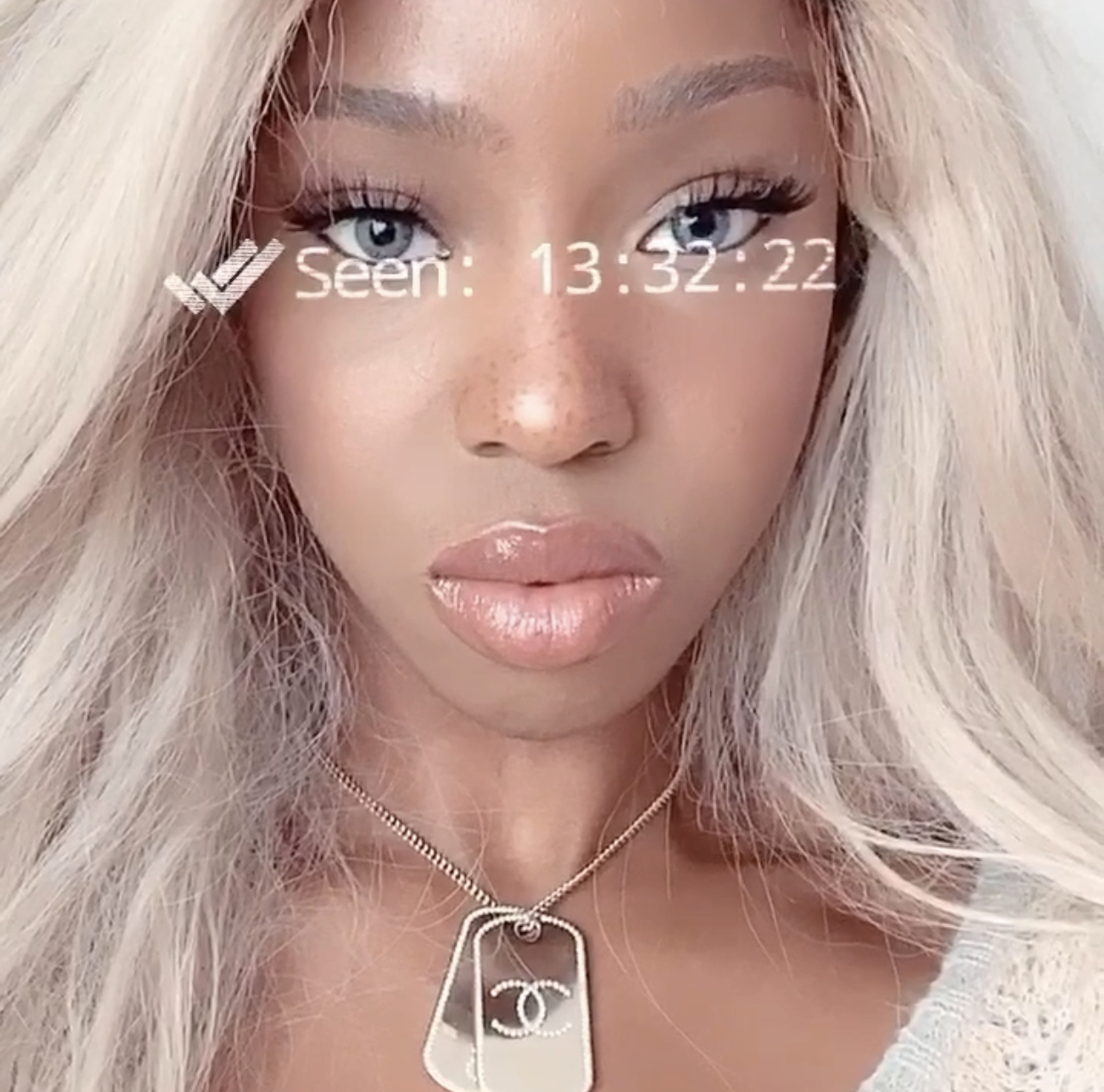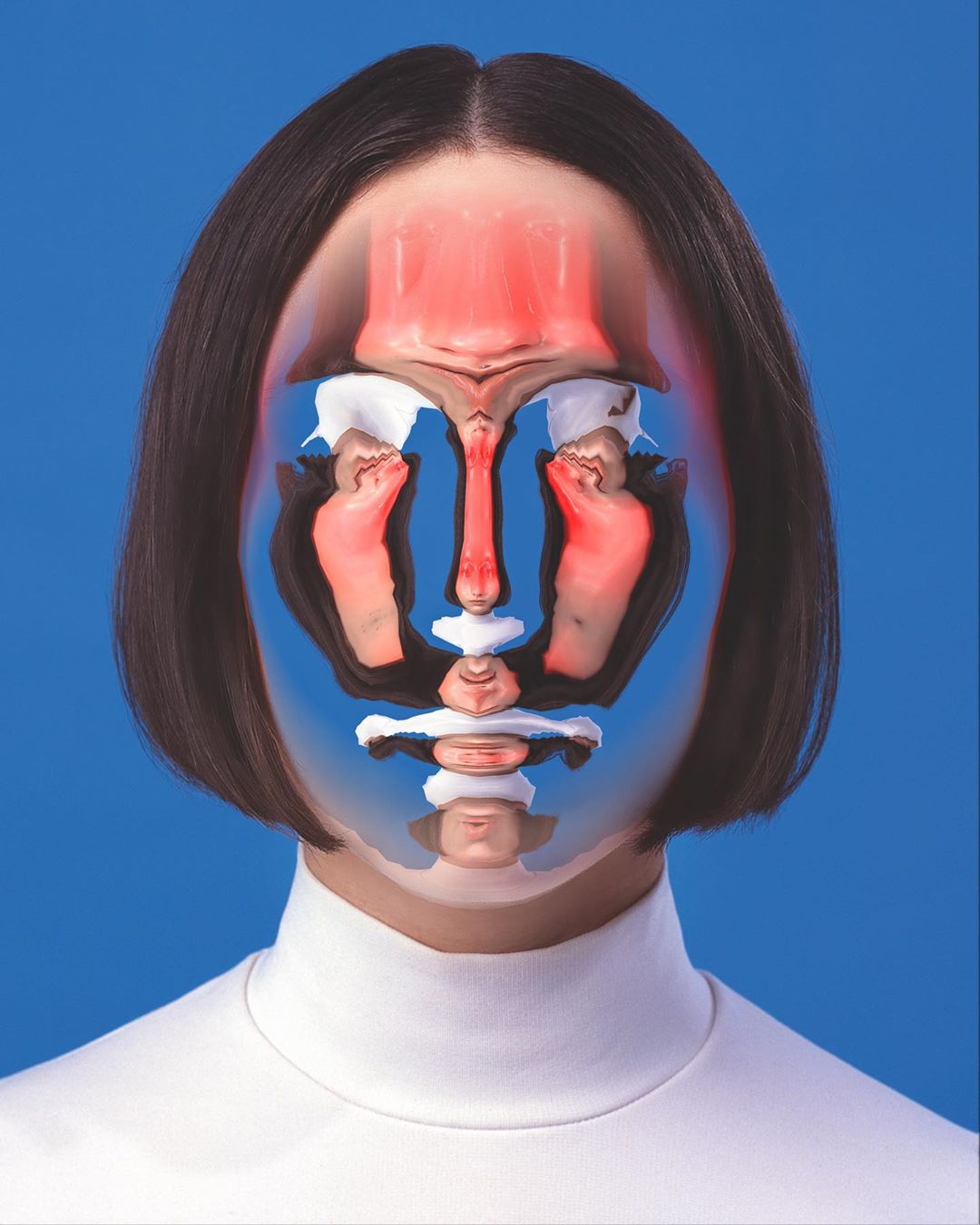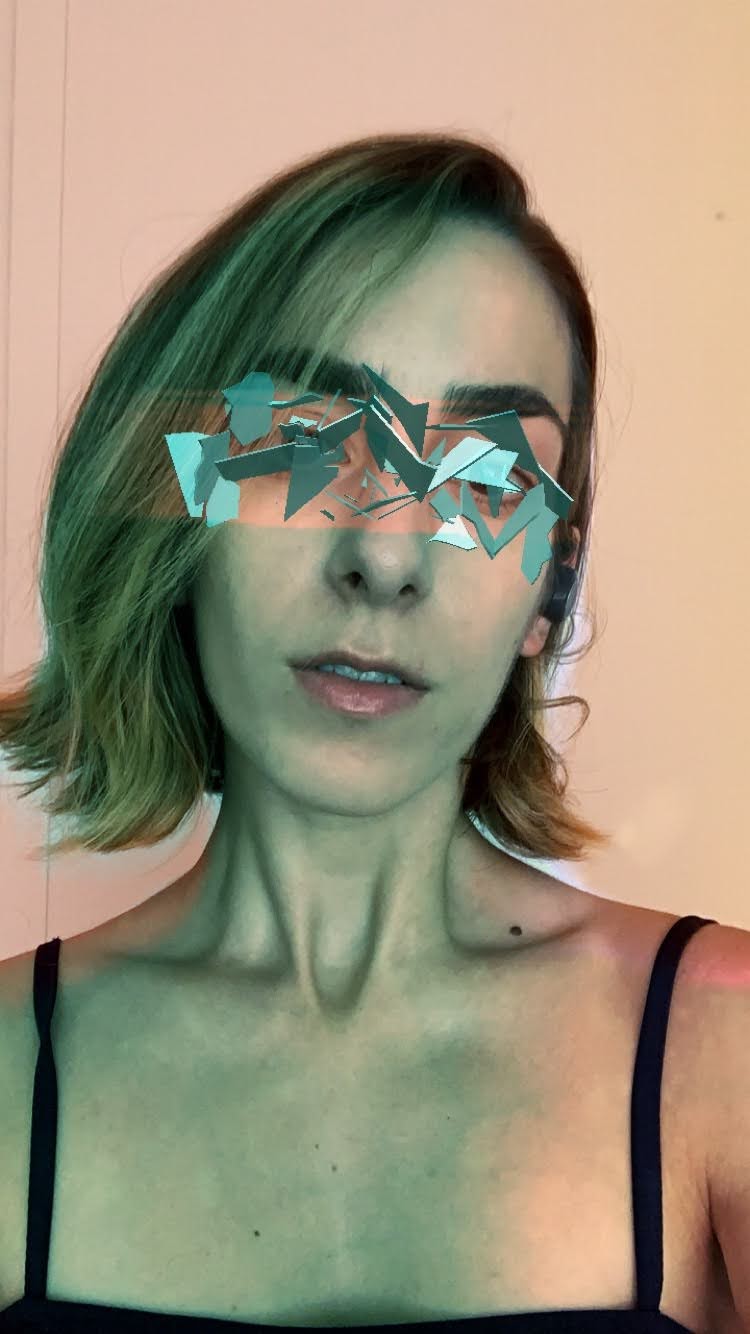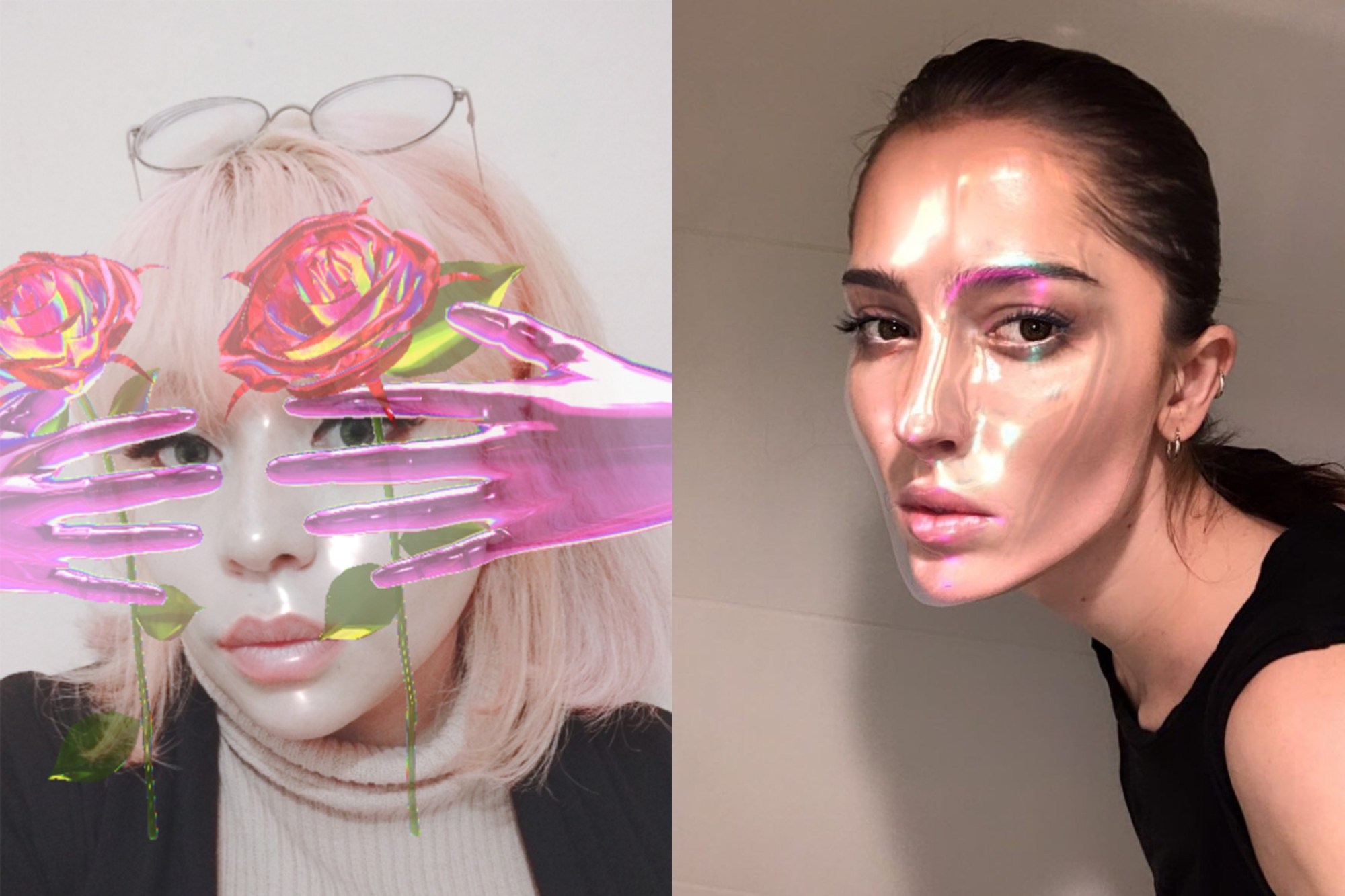Over the past six months, the world has passed the time largely at a distance from one another, and despite a beckoning summer and warm weather, in some form of isolation. Many have turned to more introspective pursuits, be it taking up activism-themed embroidery, dusting off an old pair of roller skates, adding a 16th step to skincare routines. Others have spent their days building surreal Instagram filters that play with ideas of modern beauty.
It’s no surprise that social media platforms like Instagram have seen an increase in use as people look for ways to stay connected with friends, find some entertainment and even a bit of the glamor and fashion of the real world, online. Instagram’s filters and effects have been around for a while now, but access to Spark AR, Instagram’s tool for making those effects you see everywhere — from head-tilt games to beautification filters and more — has made these custom works of tech-meets-art more popular than ever. Uniquely, while the world of tech is still largely dominated by men, the majority of creators, the people who make your favourite Instagram effects, are young women.
We spoke to some of the women who make up this diverse community of designers, artists and creators, to learn more about how they’re bridging the online and physical worlds, opening up a new medium of self-expression and expanding ideas of what beauty, aesthetics and immersive art experiences can be in the process.

Your work centres luxury aesthetics and beauty, sometimes in a tongue-in-cheek or subversive way. What inspires you to blend these elements to create Instagram filters?
“Life imitates art” springs to mind. I find myself developing programs in the areas in which I have a personal interest, which most of the time revolves around fashion and beauty as an extension of that. I’m a huge fan of logos — I find commercialism fascinating, and like to play around with that too. A lot of my work is based on target tracking, or image recognition — taking something that’s instantly recognisable, such as a luxury item, and turning that on its head or making it mine is a lot of fun for me.
What is unique about Instagram filters as a medium — does it serve as a unique palette or more of a universal one?
I see developing filters as almost like building tools for people, so I’d lean more towards calling it a universal base. It’s fun to think of filters, as it really is mind-blowing to see people’s interpretation of what you have built. What you had in mind for a filter may be the complete opposite of how it ends up being used widely. It enables interaction in such a vast way — which, to me, makes it so unique.
What does AR offer to you as an artist and creator? How does it help you connect to your audience?
AR offers clarity for me as a creator. It’s so refreshing to be able to envision something in your head and have an as-close-to-tangible product that is accessible and visible to so many people all at once. It offers a conversation — my audience can adopt and then interact with my work. I often find myself building upon, refining and updating work after it has been released, after seeing how users engage with it.
How do you view AR, or AR art’s relationship with beauty, and how we envision ourselves? How does your work push these boundaries between art, beauty, fashion and technology?
To me AR is about autonomy (hence the username @autonommy!) — it’s about having control over oneself, and one’s vision of themselves. People are becoming more self-aware and “curating” themselves a lot more, and AR in many cases provides so many opportunities for self-exploration. It’s never been so easy to experiment with a new look for yourself, without having to make the actual commitment. We’re a generation of shape-shifters, and due to AR, it’s become that much more easy to reinvent yourself.
Technology opened up new opportunities for art-making. What advice would you give to someone just starting out?
Having a background in computer science and security, technology is something I’ve always known. I’ve never considered myself an artist! I think for someone starting out, authenticity and consistency is very important when learning a new skill or program. I’d recommend immersing yourself in a community of like-minded individuals who you can learn from. Build the things that you would like to see in the world.

Your work combines the organic and the futuristic in a harmonious way; what motivates you to blend these two elements to create Instagram filters?
With AR, I like to invent things that can’t exist in real life. I don’t think I necessarily have to create things that replicate the whole world; the fun part for me is that I can create something new. My work is hybrid; I like to mix a futuristic vision in a very minimal way, so it feels almost natural. My main focus with AR on Instagram though, is the user: their face, their body and the world that surrounds them become my canvas to tell a different fragment of stories.
I’m fascinated by the future and how it changes our society. I think humanity already predicted most of the things that are happening today and what might happen tomorrow. But I also believe that we can contribute and inspire the future as well, by seeding ideas through this type of work and concepts that trigger discussions.
What is unique about Instagram filters as a medium with which to create — does it serve as a unique palette or more of a universal one, since anyone can use it?
I think the uniqueness of Instagram filters is that the final output isn’t something just contemplative and passive like a painting could be, but it is a real collaboration with the users. In a way, it’s like creating a new genre of art performance/experience where the user performs and becomes the central focus, not the effect. Without them, nothing exists anymore.
AR is such a new medium for experimentation and self-expression for artists and audiences alike. What does AR offer to you as an artist and creator? How does it help you connect to your audience?
One sure thing that I’ve never expected before making AR is that it enabled me to see the world through the users; when people from everywhere in the world are using your work, you realise how rich different cultures and subcultures are out there. Everyone is using effects in different ways, sometimes in ways you’ve never expected, it opened my mind and I’ve learned a lot about how people’s behaviour changes from one culture to another.
How do you view AR, or AR art’s relationship with beauty, and how we envision ourselves? How does your work push these boundaries between art, beauty, fashion and technology?
Art has always been pushed forward by new technologies and mediums; I think that we are experiencing a similar pattern today with social media and augmented reality. It is a new genre of performing arts, where image, style and beauty merge with technologies; it’s pretty hybrid. What happens when makeup, fashion, direction and photography merge with technology and reality-bending? I think this is just the beginning of something way more significant.
For young artists, particularly women, how has technology opened up new opportunities for art-making? What advice would you give to someone just starting out?
My advice would be the following: do whatever you want to do and what feels right for you. There is no correct way to do, no proper way to learn and no accurate way to create. The right way is to develop your method. You can get inspired by anything and anybody.

Your work centres organic styles, painterly aesthetics and beauty, what motivates you to blend these elements to create Instagram filters?
My biggest motivation when it comes to mixing elements is the challenge that this implies and the result.
In terms of aesthetics, working as a photographer allows me to identify what I like and what I don’t like. For example, I like warm tones, nature, the texture of an analog photograph. Spending time in Spark AR looking for how to mix all the elements, what external or internal tools to use and what the end result will look like is a huge challenge for me, and I must confess that I love challenges. As for the word “result”, I’m not only talking about the finished filter, but also about how people interact with it. Although the filters I create are mostly based on my own tastes, I develop effects that make people feel good. A beautiful community was created that takes every job I do and redefines it, making it their own.
What is unique about Instagram filters as a medium with which to create — does it serve as a unique palette or more of a universal one?
I would definitely say that creating an Instagram filter grants both qualities. It’s universal since anyone can use filters and anyone can create their own effects. Spark AR is very easy to get started with and it has educational tools that allow you to create without having to know a specific topic. And it’s unique because once the filter is developed, each user brings their personal touch, generating a new type of content.
How do you view AR, or AR art’s relationship with beauty, and how we envision ourselves? How does your work push these boundaries between art, beauty, fashion and technology?
The fusion between AR and beauty has given us unexpected shortcuts. It is no longer necessary to spend hours in front of a mirror putting on make-up, you have an endless range of filters that emulate make-up in real life. You can take a selfie and look made up in seconds and without any effort. Sometimes (I include myself because it usually happens to me too) we are so used to taking photos with filters, ranging from skin-tanning to completely changing the face, that when we open the front camera, inadvertently, we spend a few minutes thinking: my face really looks this way? However, never forget that (at least in my case) all my filters are created in order to entertain by providing a positive experience and that we have to love ourselves as we are.
Art, beauty, fashion and technology are words that definitely go hand in hand, they integrate perfectly. I feel that the user is the one who manages to cross these barriers, I am only giving them a tool to do it (a filter). Most of my masks are as customisable as possible so that the user can adapt their appearance to their own preference, and thus make them feel connected to their “virtual self”. And that is where the user puts so much commitment into taking a “stylised self-portrait” that it breaks the barrier of “fashion” or “beauty” to become “art.”
For young artists, particularly women, how has technology opened up new opportunities for art-making? What advice would you give to someone just starting out?
The most important thing that technology gave us is the space for us to express ourselves and that space provided was the door to new opportunities. New technologies and the Internet have provided artists with an infinite audience with which to share their ideas and creations. These incredible changes have made it possible for anyone to participate in art. Thanks to technology and social media, artists can expose their work to a global audience simply by clicking “share” on any social media platform, thus transcending cultural, geographic and social boundaries.
The main advice I can give someone who is just starting out is: don’t give up. If something doesn’t come out, don’t worry, take your time and find a way to fix it.

AR is such a new medium for experimentation and self-expression for artists and audiences alike. What does AR offer to you as an artist and creator?
The recent surge in AR integration on social platforms has made the medium and knowledge of it much more commonplace, which I think is wonderful. I also love that by utilising a live camera feed, AR doesn’t pull the user out of their environment or box them in, it unveils a new layer of the world that they live in and are present in, and intermingles with what they see every day. I think this makes AR unique, because several people can experience a work completely differently when they bring it into their own space (on top of how different art interpretation already is on the individual level).
How do you view AR, or AR art’s relationship with beauty, and how we envision ourselves? How does your work push these boundaries between art, beauty, fashion and technology?
Make-up can be a powerful tool for self-expression, and an art form in itself, but the industry as a whole also promotes toxic ideals that lead some people to think that if they leave the house with a visible pimple or less than lengthy lashes they’ll be struck down by lightning and ridiculed. It took me a long time to be comfortable just existing in my own skin (still have work to do), so the last thing I want to do is create work that leads others to think that they aren’t valid no matter how they look.
AR on social is tough in that sense, skin-smoothing, face deformations that slightly shrink the nose and slightly enlarge the lips, are extremely common. This beauty motif being widely used insinuates that these adjustments are desirable, when in reality the human form is extremely varied and amazing, and beauty standards are constantly shifting and completely made up to begin with.
For young artists, particularly women, how has technology opened up new opportunities for art-making? What advice would you give to someone just starting out?
Technology has definitely opened many doors, but unfortunately the doors themselves still aren’t as accessible as they need to be for the population at large. I think tech as an industry and a space still has a lot of work to do in terms of inclusivity. Be it gender inequality, class or race, the tech space is still full of barriers that deter people from working within it. I graduated with an engineering degree, and even though my field of study was a mix of the artistic and the technical, my classes were still very much white and male-dominated.
I’d say the best advice I can give is that bad work is good work. It’s intimidating to see people creating these beautiful mind-bending experiences, and thinking to yourself that you’ll never be able to do that. No one starts out immediately creating impeccable things. Imperfections can lead to inspiration and you’ll never improve if you don’t start! Learning materials for most digital mediums are plentiful (and a lot of them are free!), which I think is the great thing about digital fabrication. Creation software can be expensive, and that’s a barrier to entry as well, but lots of free alternatives exist and are just as good if not better than the paid tools!

